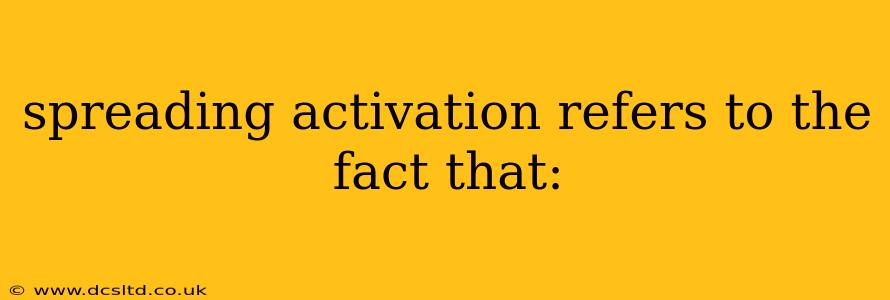Spreading activation refers to the process by which activating one concept or node in memory triggers the activation of related concepts or nodes. Imagine a spiderweb: pulling on one strand causes ripples and vibrations throughout the entire structure. Similarly, when you think of one thing, related ideas and memories are automatically activated, even if you aren't consciously trying to recall them. This unconscious activation influences your thoughts, feelings, and behaviors in subtle yet powerful ways.
How Does Spreading Activation Work?
Spreading activation is a core concept in cognitive psychology, particularly within the framework of network models of memory. These models represent memory as a vast network of interconnected nodes, each representing a concept, idea, or piece of information. The connections between these nodes represent the associative links between concepts. The strength of these links varies depending on how frequently and recently the concepts have been associated.
When a node is activated (e.g., you think about "dog"), the activation spreads along the connecting pathways to related nodes. This spread isn't uniform; stronger links lead to faster and more potent activation. So, thinking about "dog" might quickly activate related nodes like "puppy," "bark," "tail," "loyal," even "cat" (through a weaker, contrasting link). The further the activation spreads, the more extensive the influence on your current thoughts and actions.
What are the Implications of Spreading Activation?
The implications of spreading activation are far-reaching and impact various aspects of cognition:
-
Priming: Spreading activation explains the phenomenon of priming, where exposure to one stimulus influences the response to a subsequent stimulus. For example, if you've recently seen a commercial about a particular brand of car, you might be more likely to choose that car when making a purchase later, even unconsciously.
-
Problem Solving: The spread of activation can help you find solutions to problems by triggering associations that lead to insightful connections. If you're stuck on a problem, thinking about related concepts might activate a node containing the solution.
-
Memory Retrieval: Spreading activation is crucial for retrieving information from long-term memory. A cue or prompt activates a relevant node, triggering the activation of associated nodes, eventually leading to the retrieval of the target memory.
-
Understanding Language: When you read or hear a sentence, spreading activation helps you understand the meaning by connecting the words to their associated concepts and relationships.
-
Emotional Contagion: Seeing someone happy can activate associated nodes related to happiness in your own mind, potentially influencing your mood positively. Conversely, exposure to negative emotions can trigger similar negative associations in your own cognitive network.
Frequently Asked Questions about Spreading Activation
Here are some common questions about spreading activation, answered with clarity and precision:
What is the difference between spreading activation and semantic network?
A semantic network is a model that explains how concepts are organized and related in memory. Spreading activation is a process that occurs within a semantic network. The network provides the structure, and spreading activation describes how information flows through that structure.
How does spreading activation relate to cognitive biases?
Spreading activation can contribute to various cognitive biases. For example, confirmation bias might occur because the activation of information confirming pre-existing beliefs is faster and stronger than the activation of contradictory information.
Can spreading activation be experimentally measured?
Yes, researchers use various techniques like response time measures and priming paradigms to measure the speed and extent of spreading activation. These studies provide empirical evidence supporting the existence and influence of this cognitive process.
What are some real-world examples of spreading activation?
Real-world examples abound: Seeing a picture of a beach might activate thoughts of summer vacation, relaxation, and the sound of ocean waves. Hearing a particular song might trigger memories associated with a specific time or person in your life. These spontaneous, involuntary associations are all driven by spreading activation.
Understanding spreading activation provides valuable insight into the complex workings of the human mind, highlighting the interconnectedness of our thoughts, memories, and emotions. This unconscious process significantly influences our cognitive experiences and shapes how we interact with the world around us.
